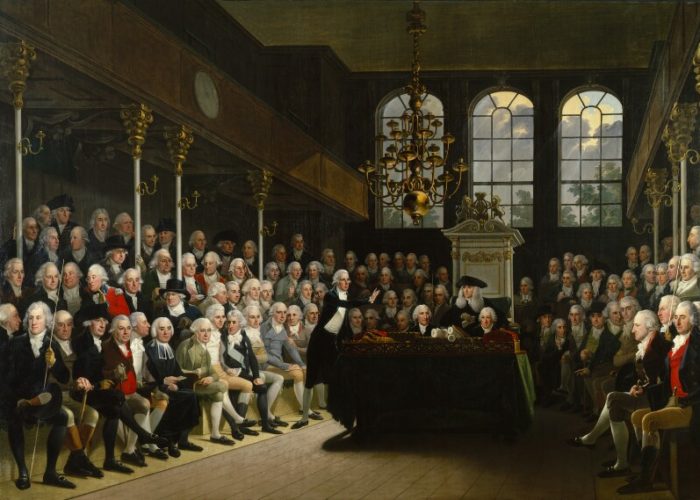The House of Commons 1783-94 by Karl Anton Hickel
Theme: Political Revolution, Challenging law and order: British riots and reforms, British politics in the Age of Revolution
William Pitt the Younger was Prime Minister of Britain through the French Revolutionary and early Napoleonic Wars in the late 1700s and beginning of the 1800s. He was known as ‘the younger’, to distinguish him from his father, who was also named William Pitt and led the Government in the mid 1700s. This painting shows William Pitt the Younger addressing the House of Commons.
William Pitt (1759 – 1806) the Younger was highly intellectual and encouraged by his father from a young age to follow in his footsteps. He studied at Cambridge University from the age of just 14, where he met his lifelong friend William Wilberforce – famous for his part in the anti-slavery campaign. Pitt began his parliamentary career in 1780, sneaking in through the pocket borough of Appleby in 1781 having lost the Cambridge seat he contested, and remarkably became Prime Minister just two years later, aged only twenty-four.
As Prime Minister, Pitt steered Britain through a series of national crises including the ‘madness’ of King George III, the French Revolution, the rise of Napoleon and the resulting wars. His government also introduced a series of laws repressing the freedom of ordinary people living in Britain, preventing them from meeting in large groups or publicising ideas that might challenge the authority of the monarchy and the government. These included the famous ‘gagging acts’, a response to what Pitt saw as the dangerous troublemaking of radicals inspired by the French Revolution and the fear that ordinary British people might rise up in rebellion against authority – as had taken place in France.
In 1798 the Irish Uprising led to the Act of Union, which saw the United Kingdom of Britain and Ireland come into being on January 1 1801. This was a major triumph for Pitt. But a disagreement with the King about the rights of Catholics forced him to resign later that year. Pitt became Prime Minister again in 1804 but was dogged by failing health and died in 1806.
This image shows Pitt addressing the House of Commons. It marks his response to the declaration of war on Britain by the French Revolutionary Government in February 1793, a crucial moment in his career. Up to this point Pitt had pursued three main objectives: to reduce the national debt, reform the parliamentary system, and bring Catholic emancipation to Ireland. He also shared his friend Wilberforce’s concerns about the slave trade. However, from this point forward, his entire career as Prime Minster was dominated by the economic and social affects of war. The artist, Karl Anton Hickel, was an Austrian, and his picture may have been a response to Jacques Louis David’s sketch of the French Estates General in 1789.
It is thought that Wilberforce is identifiable as the intent face in the top row, leaning forward, sixth from the left. Charles James Fox (arch rival of Pitt) can be seen sixth from the right on front row, holding a cane and wearing a black hat.
For a list of all members of parliament featured in this image visit the National Portrait Gallery website.
Did you know..?
At the age of 24, William Pitt the Younger was Britain’s youngest ever prime minister.
Sources & acknowledgements
This object description and its related educational resources were researched and written by our team of historians and education specialists. For further information see the item’s home museum, gallery or archive, listed above.
-
Did you know..?
At the age of 24, William Pitt the Younger was Britain’s youngest ever prime minister.
-
Education overview
You can access a range of teachers resources related to this object and more on our education page.
Please also see our glossary of terms for more detailed explanations of the terms used.
-
Curatorial info
- Originating Museum: National Portrait Gallery
- Accession Number: NPG 745
- Production Date: 1793-1795
- Creator: Karl Anton Hickel
- Technique: Oil on canvas
- Size: 127 in. x 177 in. (3226 mm x 4496 mm)
- Original record
-
Use this image
You can download this image for personal and educational use but please take note of the license type below.
- Rights Holder: National Portrait Gallery, London
- License Type:
Find it here
This object is in the collection of National Portrait Gallery



